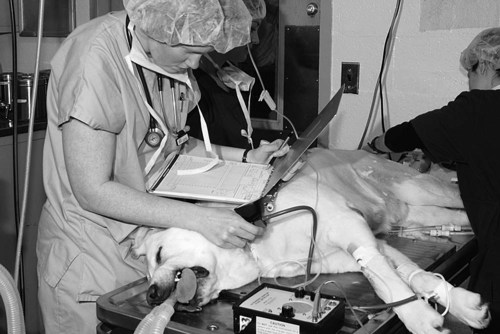I Anesthesia’s purpose is to produce a convenient, safe, effective, and economical means of facilitating medical and surgical procedures while minimizing stress, pain, discomfort, and adverse side effects to the subject and attending personnel. II Criteria for selection of drugs and techniques A Species, breed, age, weight, and body type C Physical status and coexisting disease processes D Nature, location, and severity of pain E Current and past medications F Knowledge and experience of personnel (Fig. 1-1) G Familiarity with available equipment and techniques III Responses vary because drug doses and techniques are initially developed for the “average, normal, healthy” animal; thus, it is essential that drugs, drug dosages, and anesthetic techniques are selected based on the subject’s physical status (developed by the American Society of Anesthesiologists: ASA) A Physical Status 1— A normal healthy patient B Physical Status 2—A patient with mild systemic disease C Physical Status 3—A patient with severe systemic disease D Physical Status 4—A patient with severe systemic disease that is a constant threat to life E Physical Status 5—A moribund patient who is not expected to survive without the operation A Medical terms used in the practice of anesthesia: Most definitions of anesthesia incorporate a loss of feeling (analgesia) and/or awareness (unconsciousness). Muscle relaxation and a reduction in the stress response are added benefits. Acupuncture: The stimulation of specific trigger points based on traditional Chinese medicine Additive: An effect in which two substances or actions used in combination produce a total effect the same as the sum of the individual effects. Agonist: A drug that produces an effect by interacting with a specific receptor site (e.g., opioid agonist morphine) Akinesia: Loss of motor response (movement) usually caused by blockade of motor nerves Allodynia: Pain evoked by a stimulus that does not normally cause pain Analeptic: a central nervous system (CNS) stimulant or respiratory stimulant Analgesia: Loss of sensitivity to pain; relief of pain without loss of consciousness Anesthesia: Total loss of sensation in a body part or in the whole body, generally induced by a drug or drugs that depress the activity of nervous tissue either locally, regionally, or generally (centrally). The act of producing anesthesia is generally divided into phases that include the preanesthetic, anesthetic, and postanesthetic periods (see box) Balanced anesthesia: Surgical anesthesia produced by a combination of two or more drugs or anesthetic techniques, each contributing its own pharmacologic effects; includes tranquilizers, opioids, nitrous oxide, muscle relaxants, and inhalants Dissociative anesthesia: A CNS state characterized by catalepsy, analgesia, and altered consciousness; produced by drugs such as ketamine and tiletamine General anesthesia: (1) Loss of consciousness in addition to loss of sensation; (2) ideally includes hypnosis, muscle relaxation, analgesia, and suppression of stress; can be produced with a single drug or by a combination of drugs Local anesthesia: Analgesia generally limited to a specific area where the anesthetic drug is applied or injected Regional anesthesia: Analgesia limited to a circumscribed region of the body produced by blocking sensory nerves Surgical anesthesia: Loss of consciousness and sensation accompanied by sufficient muscle relaxation and analgesia to allow surgery to be performed without pain or movement by the animal Antagonist: a drug that counteracts the effects of another drug (e.g., opioid antagonist naloxone) Catalepsy: State characterized by a lack of response to external stimuli and by muscular rigidity, so that the limbs remain in whatever position they are placed Central sensitization: An increase in nerve excitability and responsiveness in the CNS, particularly the spinal cord Distress: (1) State produced when the biologic cost of stress negatively affects biologic functions critical to the animal’s well-being; (2) to cause pain or suffering or to make miserable Euthanasia: Loss of consciousness and death without causing pain, distress, anxiety, or fear Homeostasis: A state of equilibrium within the body; a relatively stable equilibrium between interdependent physiological processes Hyperalgesia: An increased or exaggerated response to a stimulus that is normally painful (a heightened sense of pain) either at the site of injury (primary) or in surrounding undamaged tissue (secondary or extraterritorial). Stimulated nociceptors respond to noxious stimuli more vigorously and at a lower stimulus intensity. Hypnosis: Artificially induced sleep or a trance resembling sleep from which the animal can be aroused by a sufficient stimulus; animals cannot be aroused during general or surgical anesthesia MAC (minimum alveolar concentration): (1) A term used to describe the minimum alveolar concentration of inhalant anesthetic required to prevent movement in response to a noxious stimulus in 50% of anesthetized animals; (2) infrequently, in human outpatient anesthetic practice, used to mean monitored anesthesia care Multimodal therapy: The use of multiple drugs with different mechanisms of action to produce optimal analgesia Narcosis: Drug-induced stupor or sedation with or without hypnosis Neuroleptanalgesia: Hypnosis and analgesia produced by the combination of a neuroleptic drug (i.e., tranquilizer) and an analgesic drug Pain: An aversive sensation and feeling associated with actual or potential tissue damage Adaptive pain: Pain that produces behavior that promotes healing and recovery Inflammatory pain: Pain associated with tissue damage and the infiltration of immune cells; it can promote repair by causing pain hypersensitivity until healing occurs Maladaptive pain: Pain that tends to be out of all proportion to actual tissue damage and which persists long after the tissues have healed so that the pain becomes the problem Pathologic pain: A disease state caused by damage to the nervous system (neuropathic) or by its abnormal function (dysfunctional). Pathological pain is maladaptive and usually includes peripheral sensitization, central sensitization, and hypersensitivity resulting in allodynia. Dysfunctional pain is pain caused by abnormal function of the nervous system; often considered to be pain in the absence of disease Neuropathic pain is caused by damage or disease affecting any part of the nervous system
Introduction to Anesthesia
Overview
General Considerations
![]()
Stay updated, free articles. Join our Telegram channel

Full access? Get Clinical Tree



